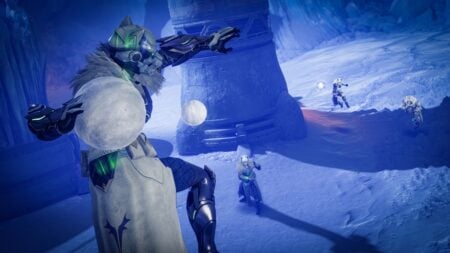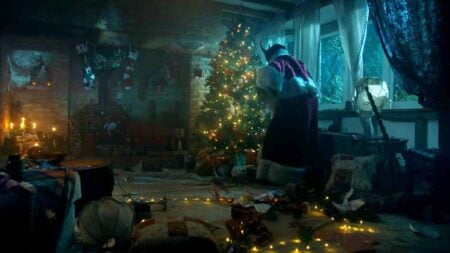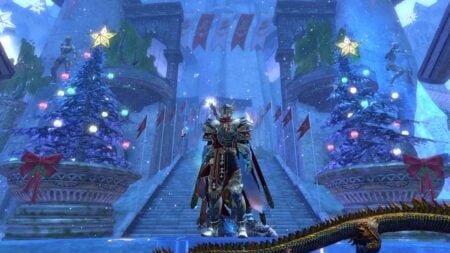Skip To...
Prince of Persia: The Lost Crown is a new direction for a classic series that has undergone multiple transformations over the years. While its origins were in the 2D action-adventure genre, subsequent Prince of Persia games that came after focused more on 3D cinematic action and combat. But after getting hands-on time with Ubisoft’s latest entry in the series, I can say The Lost Crown blends classic and modern elements in a very interesting way. As a revival of Prince of Persia, taking the series in the direction of Metroidvania-style design was the best move forward.
A Loosely Connected Prince’s Legacy
The story of The Lost Crown isn’t related to previous games. But that doesn’t mean that fans of Prince of Persia won’t recognize some elements synonymous with the series. The hero we control is a young man named Sargon, who is part of a group called the Immortals. They are tasked with rescuing the kidnapped Prince Ghassan from the cursed city of Mount Qaf, all while a mysterious plot begins to unfold.
On the surface, The Lost Crown seems like a completely new take on the franchise that was only vaguely related to what came before. But after playing through its beginning hours, I noticed more elements of the series littered throughout. From the perspective of the gameplay to the allusion to time manipulation being a factor in the plot, there were many connections to the beloved aspects of Prince of Persia games that long-time fans would appreciate. All of it was being brought together in a way that wasn’t done with the series before but made sense for an action-adventure game being released in the modern day.
Classic Danger for A New Persia
Many who have played older Prince of Persia games are familiar with 2D platforming across treacherous obstacles and solving puzzles. While there was still combat in some form, the older games put a heavy emphasis on agility and quick reaction to the dangers that lay ahead. I was constantly jumping and sliding across terrain to avoid deadly traps that blocked my path. What I quickly saw in my time playing this new entry of the series gave a fresh coat of paint to a core element of the series while bringing in modern ideas from other Metroidvania games.
Metroidvania titles are seen more often these days, with varying degrees of success, but the popular ones become major standouts to those who love 2D action and exploration. Games like Dead Cells, Bloodstained: Ritual of the Night, and Hollow Knight push players into tough situations that require them to react fast and jump around while taking advantage of opportunities that vanish quickly. Yet, at the same time, it rewards players who take the risk to explore their surroundings and face new obstacles and challenges that open up the world around them. It’s a great approach to gameplay that works for a series like Prince of Persia and one that is implemented phenomenally with The Lost Crown.
Some of the best moments I had with Prince of Persia: The Lost Crown involved dashing through areas with my agility and overcoming dangerous obstacles to explore deeper into Mount Qaf. I would avoid spikes coming out of walls while jumping to higher platforms, which could lead me to swing blades or grinders near slopes that force me to slide downward. And just like other Metroidvania games, I had to figure my way through it all if I wanted to see what was on the other side and go further. While the challenge of these platforming obstacles can be tedious, it always led to something new or rewarding that kept me going.
Fresh Combat for the Prince of Persia
Just because this Prince of Persia has you platforming your way across danger, it doesn’t mean you’ll avoid a fight. Combat in Prince of Persia: The Lost Crown takes inspiration from the 3D era of the series, especially games like Prince of Persia: The Sands of Time or Warrior Within. Unlike other games in the genre that offer simple attacks, this Prince can attack with combos and link new abilities together to damage enemies.
However, being a smart fighter that capitalizes on the right opportunity is better for enemies that require more than just button-mashing attacks. Sargon isn’t a powerhouse that can take any attack thrown at him, so he’ll sometimes need to be more tactical in his approach.
I found myself often waiting for enemies to attack me first so I could use a Parry to make them vulnerable. This was great for taking out tougher enemies quickly while also making armored foes open to attacks and big damage more often. This was especially important with boss battles that Sargon will encounter, which can be cinematic and very challenging at the same time.
Getting the right timing with a parry or dodge keeps the combat rewarding, especially for quick reactions and wit in the heat of the moment. Like in other Metroidvania games with a similar approach to combat, careful timing can make or break you in battle against a tough enemy.
Having Prince of Persia: The Lost Crown developed like a Metroidvania title was the best direction that the series could go. Its action and exploration mesh together well while still keeping true to its platforming roots that made it the series it is today.
What fans are getting is a nice blend of the new and old parts they love about Prince of Persia delivered as something entirely new. Even though I played hours of the beginning sections of Prince of Persia: The Lost Crown, there is much more to discover when the full game finally releases on January 18, 2023, for all platforms. I can’t wait to see what other secrets The Lost Crown reveals when it’s found by Prince of Persia fans.












